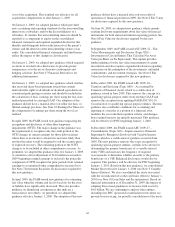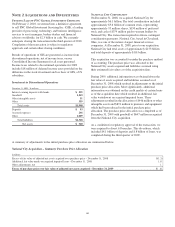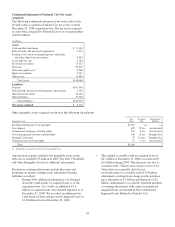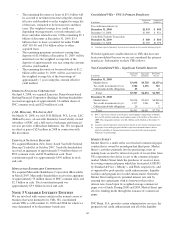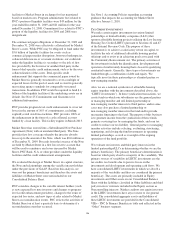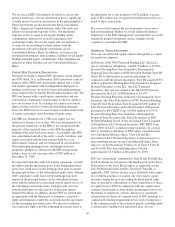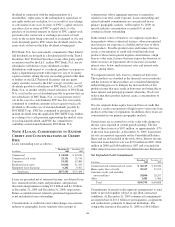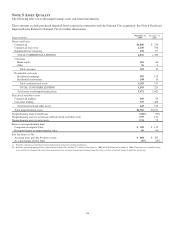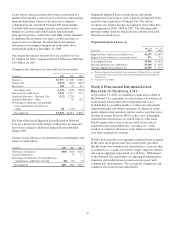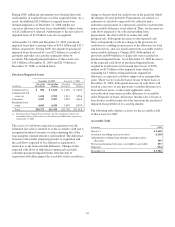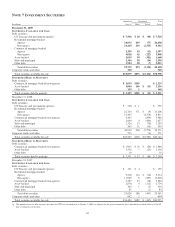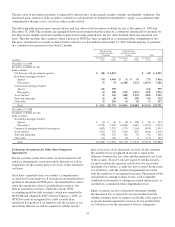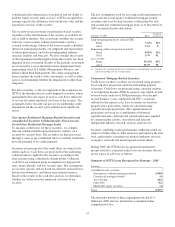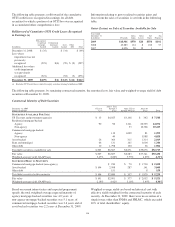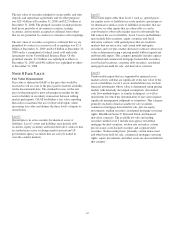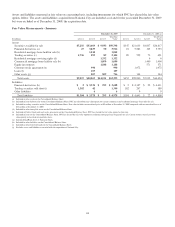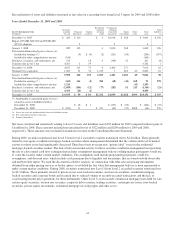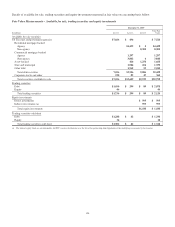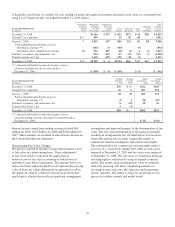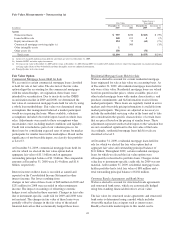PNC Bank 2009 Annual Report Download - page 116
Download and view the complete annual report
Please find page 116 of the 2009 PNC Bank annual report below. You can navigate through the pages in the report by either clicking on the pages listed below, or by using the keyword search tool below to find specific information within the annual report.
During 2009, additional information was obtained about the
credit quality of acquired loans as of the acquisition date. As a
result, an additional $2.6 billion of acquired loans were
deemed impaired as of December 31, 2008 and the net
carryover allowance for loan losses attributable to these loans
of $112 million was released. Adjustments to the fair value of
impaired loans of $1.8 billion were also recognized.
At December 31, 2009 and December 31, 2008, purchased
impaired loans had a carrying value of $10.4 billion and $12.7
billion, respectively. During 2009, the amount of purchased
impaired loans decreased by a net $2.3 billion as a result of
payments and other exit activities primarily offset by
accretion. The unpaid principal balance of these loans was
$15.4 billion at December 31, 2009 and $21.9 billion at
December 31, 2008, as detailed below:
Purchased Impaired Loans
December 31, 2009 December 31, 2008
In millions
Recorded
Investment
Outstanding
Balance
Recorded
Investment
Outstanding
Balance
Commercial (a) $ 558 $ 1,016 $ 1,016 $ 2,485
Commercial real
estate (a) 1,694 2,705 1,911 3,856
Consumer 3,457 5,097 3,887 6,618
Residential real
estate 4,663 6,620 5,895 8,959
Total $10,372 $15,438 $12,709 $21,918
(a) Includes purchased impaired loans held for sale. The recorded investment and
outstanding balance of these loans was $85 million and $200 million, respectively,
at December 31, 2009.
The excess of cash flows expected at acquisition over the
estimated fair value is referred to as the accretable yield and is
recognized in interest income over the remaining life of the
loan using the constant effective yield method. The difference
between contractually required payments at acquisition and
the cash flows expected to be collected at acquisition is
referred to as the nonaccretable difference. Changes in the
expected cash flows of individual commercial or pooled
consumer purchased impaired loans from the date of
acquisition will either impact the accretable yield or result in a
charge to the provision for credit losses in the period in which
the changes become probable. Prepayments are treated as a
reduction of cash flows expected to be collected and a
reduction of projections of contractual cash flows such that the
nonaccretable difference is not affected. Thus, for decreases in
cash flows expected to be collected resulting from
prepayments, the effect will be to reduce the yield
prospectively. Subsequent decreases to the expected cash
flows will generally result in a charge to the provision for
credit losses, resulting in an increase to the allowance for loan
and lease losses, and a reclassification from accretable yield to
nonaccretable difference. During 2009, $646 million of
provision and $90 million of charge-offs were recorded on
purchased impaired loans. As of December 31, 2009 decreases
in the expected cash flows of purchased impaired loans
resulted in an allowance for loan and lease losses of $556
million on $7.9 billion of the impaired loans while the
remaining $2.5 billion of impaired loans required no
allowance as expected cash flows improved or remained the
same. There was no such allowance on any of these loans at
December 31, 2008. Subsequent increases in cash flows will
result in a recovery of any previously recorded allowance for
loan and lease losses, to the extent applicable, and a
reclassification from nonaccretable difference to accretable
yield. Disposals of loans, which may include sales of loans or
foreclosures, result in removal of the loan from the purchased
impaired loan portfolio at its carrying amount.
The following table displays activity for the accretable yield
of these loans for 2009.
Accretable Yield
In millions 2009
January 1 $ 3,668
Accretion (including cash recoveries) (1,118)
Adjustments resulting from changes in purchase price
allocation 349
Net reclassifications from non- accretable to accretable 837
Disposals (234)
December 31 $ 3,502
112


